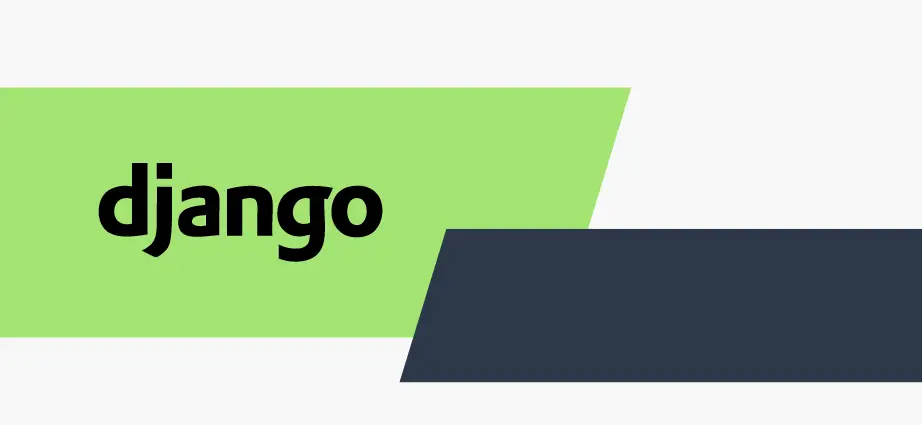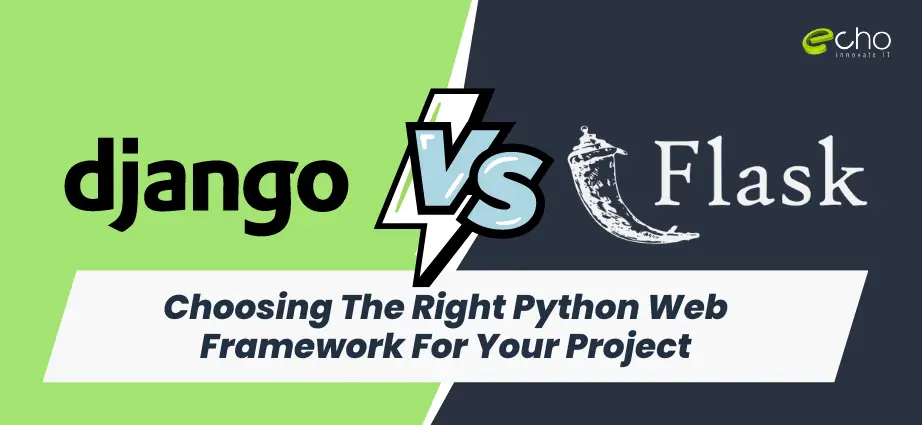Django vs Flask; which one to choose?
Do you need clarification about which Python web framework is right for your business? Python is one of the most highly used programming languages with a market share of 28.11% based on the statistics of PYPL. Since Python is a popular choice for every development team, choosing the best Python framework may become a daunting task.
Python web frameworks are a collection of modules and packages that assist developers in writing codes in the Python programming language. They provide quick, reliable, and seamless software solutions that help developers in various activities like app structuring, web designing, and administering systems to create a structure. Today we are going to understand and compare two of the most popular web frameworks i.e. Django and Flask. But before that let’s know what are some benefits of using the Python Web Frameworks in the app development process.
Benefits Of Using Python Frameworks
- Time-Saving: Python frameworks provide pre-built modules and libraries, saving you valuable time. Instead of reinventing the wheel and building code from scratch, you may use these pre-built components to accelerate development. This allows you to focus on the particular elements of your application and produce results more quickly.
- Structured and Logical: Django and other frameworks use the model-view-controller (MVC) paradigm, which allows you to organize your code logically and systematically. Furthermore, this separation of concerns improves codebase maintainability and scalability. It also promotes code reuse, which reduces repetition and simplifies your life.
- Flexibility and Customization: Python frameworks provide a blend of structure and flexibility. They give a stable foundation while allowing you to tweak and extend functionalities based on your project’s needs. You can add or delete components as needed to ensure that the framework fits your specific use case.
- Testing and Debugging: Many Python frameworks offer good support for testing and debugging. They include built-in tools and libraries that make writing tests easy while also ensuring code stability and quality. Furthermore, this helps to identify defects early in the development process, resulting in a more reliable and resilient application.
What is Django?

Django is essentially an open-source web framework on steroids, emphasizing the product’s business value rather than forcing you to make technology decisions. As a result, the framework is sometimes seen as an enterprise solution, suitable for larger businesses that must handle significant traffic.
It also has a template system, built-in object-relational mapping (ORM), and a customizable admin panel. The framework employs a “convention over configuration” approach, making template customization and modification more difficult for developers in exchange for simpler development and maintenance with less external input.
What is Flask?

Flask is a microframework that provides all of the essential functionalities of a web application. Python’s extensive library and extension base make it simple to get started and extend. The framework’s capabilities are limited on their own, and further functionality must be supplied using supplemental technologies.
In many ways, it takes the opposite approach to Django, allowing developers to tweak and tailor it to their specific needs at will. With Flask, you may easily diversify the structure of your software project by using microframeworks. This open-source framework is characterized by its flexibility.
Django vs Flask: Key Features To Know About
Django
- Rapid Development: Django focuses on getting you up and running quickly. It provides pre-built components for standard web application functionality like user authentication, content administration, and database management, which saves time during the development cycle.
- Security: Django takes security very seriously. It has capabilities that protect against typical online vulnerabilities such as SQL injection and cross-site scripting (XSS) assaults. Additionally, the framework’s design promotes secure coding techniques.
- Scalability: Django is designed to support expanding applications. Several high-traffic websites, including Instagram and Pinterest, make use of Django’s flexibility to grow and handle increasing user loads.
- Versatility: Due to its versatility, Django is appropriate for a wide range of online projects. Django’s capability can be used to build a variety of web applications, including content management systems, social networks, and e-commerce platforms.
- Open source and Free: It means it has a big and active developer community behind it. This translates to substantial documentation, tutorials, and third-party libraries, as well as a helpful community that can answer your problems.
Also Read:
Flask
- Lightweight and Minimalist, keeping things simple: It focuses on delivering essential web development features such as routing, request processing, templating, and unit testing. This condensed approach makes Flask simple to understand and use, while simultaneously providing you with more control over the structure of your application.
- Flexibility and Customization: Flask’s modular design shines through. You can enhance its capabilities using a variety of third-party extensions, allowing you to personalize the framework to your exact requirements. This flexibility allows you to select only the components you need while avoiding features you don’t.
- Unit testing support: Flask encourages the use of unit testing by providing built-in support for integrating unit testing frameworks into your development workflow.
- Large Community and Extensive Documentation: Despite its simplicity, Flask has a vibrant community and extensive documentation. This translates to a wealth of materials available online, such as tutorials, examples, and community forums for troubleshooting and exchanging information.
Django vs Flask: Advantages and Disadvantages
Pros of Using Django Framework
- Rapid development
- Secure coding
- Scalability
- Batteries-included
- Versatile and comprehensive
- Python integration
- Open-source and free to all
Cons of Using Django Framework
- Not everyone can go with the “Django Way”
- Too complex for small projects
- Rigid structure
- Template errors
- Not beginner friendly
Also Read:
Pros of Using Flask Framework
- Easy to learn
- Fast development process
- Lightweight and minimalist
- RESTful API support
- Control over project structure
- Low resource usage
- Large community and extensive resources
Cons of Using Flask Framework
- Limited built-in features
- Security considerations
- Complexity at scale
- Debugging challenges
- Not ideal for beginners
Django vs Flask: Compatibility
Django templates are strongly integrated into the Django framework. Django-specific features include template inheritance and template tags. Jinja2 is an independent template engine that works with a variety of frameworks, including Django and Flask. Django templates are the default choice for Django apps, however, you may also utilize Jinja2 with Django.
Django vs Flask: Database
Django features its own simple yet powerful ORM that supports a variety of relational databases, including SQLite, PostgreSQL, MariaDB, and Oracle. The ORM facilitates the production and management of database migrations.
Flask, on the other hand, does not constrain how data is saved, therefore there is a large choice of libraries and extensions available for it.
Django vs Flask: Authentication and Authorization
Django’s built-in authentication system can handle both. It supports both users and user groups and includes tools for granting and verifying permissions. There are also some third-party packages for sophisticated authentication features, such as SSO, LDAP, and two-factor authentication. Django also includes an admin interface. The built-in admin app offers a ready-to-use interface for content management. After registering your models in admin.py, you’ll be able to do CRUD (create, read, update, and delete) on them.
Flask, on the other side, Flask lacks login and authorization mechanisms by default because of its lightweight nature. However, some extensions can be integrated into your Flask application and function seamlessly together. Flask-Admin, for example, provides an admin interface in addition to ORM support, whereas Flask-Login and Flask-Security provide key authentication functionality. The disadvantage of this strategy is that these extensions are independent of Flask and have their release cycles, which may cause backward compatibility concerns.
Django vs Flask: Time of Development
Django’s built-in functionality and little code use make it ideal for speedy development, especially if you have a tight deadline. For example, Django allows developers to produce a minimal viable product (MVP) faster than Flask. That is why Django is perfect for launching large websites.
In contrast, flask often takes a “build from scratch” approach to the majority of your website, making full-fledged web application development time-consuming. If you’re a more sophisticated user, the limited native development features may slow down your development timetable.
Django vs Flask: Ease of Use
Django is a difficult online solution that necessitates substantial ability to build a sophisticated application, including terminal commands, advanced Python programming skills, variables, loops, and functions. However, it offers a lot more documentation than Flask because it is a full-stack framework, not a minimalist one.
If you’re a beginner but already know Python, Flask’s simplistic structure is simple to understand. When it comes to machine learning models, Flask is considerably more user-friendly for beginners than Django. It also uses fewer lines of code.
Django vs Flask: Features and Functionalities
Django has several essential features, as well as a few extensions. Flask has a wider range of features. However, having the majority of the necessary functionalities built into a framework is always advantageous, and Django leads the way in this regard.
Flask’s functionality is mostly driven via extensions. Whether you need to integrate databases or apply additional security measures, there is an extension for practically everything.
Django vs Flask: Speed and Performance
Django is an excellent choice for individuals who want to construct more complex projects quickly and easily. Django can produce speedy results and seamlessly move applications from concept to completion.
Flask aspires to be as basic as possible while also being extensible, allowing for easy future project extension. Its simple, flexible, and lightweight design enables developers to create small programs in less time. As we can see, both frameworks relatively provide fair speed and performance, Flask wins the race with less resource consumption helping developers finish projects by using half the number of code lines.
Django vs Flask: Security
Django’s vast codebase allows for more nefarious operations. However, Django is extremely secure by default and provides numerous integrated security mechanisms such as scripts, user password hashing, CSRF tokens, and authentication and authorization modules. Furthermore, the Django development team swiftly and proactively reports any discovered security problems.
Even while Flask has fewer code requirements than Django, making it less vulnerable to cyber threats, it is still highly reliant on third-party extensions, implying that an application’s security is only as good as its weakest plugin. This raises your development team’s obligation to maintain security up to date by reviewing and monitoring third-party libraries and extensions. Overall, Django is easier to secure upfront and maintain over the life of your app.
Conclusion
Django vs Flask: Who wins the race?
In conclusion, we have compared both Python frameworks on different parameters and found both as superior in one or the other. Take, for instance, development time and security, Django wins. But when it comes to performance, speed, and ease of learning, Flask takes the lead. Flask is simpler, whereas Django is better suited for large-scale projects that require rapid development and have more integrated functionality. Overall, Both frameworks are fantastic for developing web apps, and the ideal one for your project will be determined by its size, demands, and current requirements.
Want to learn more about Python-based frameworks? No matter what framework you choose for your project; Echoinnovate IT will make the journey set right. Get in touch today to kickstart your next big project for Python-based web applications.
Also Read:
FAQs- Django vs Flask
Which one is easier to learn, Django or Flask?
Flask is generally considered easier to learn due to its simplicity and minimalistic approach, while Django provides more built-in features but comes with a steeper learning curve.
Which one is better for beginners?
Flask is often recommended for beginners due to its simplicity and minimalistic design, making it easier to grasp the fundamentals of web development.
Which one is more suitable for larger applications?
Django is typically better suited for larger applications with complex requirements due to its built-in features like ORM, admin interface, and authentication system.
Which one has a larger community and ecosystem?
Django has a larger community and ecosystem with extensive documentation, plugins, and packages available for various functionalities, while Flask has a more lightweight ecosystem but still has strong community support.



